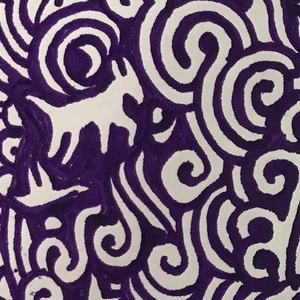
If you take a stroll up 7th street in Bogota, Colombia, which runs north south almost directly under the curtain of mountains on the eastern side of the city, and which is pedestrian for much of it’s trajectory near the historical centre, then you are participating in the activity known as “El” Septimazo" - the big seven.
All along the street are people selling second-hand wares laid out on tarpaulins on the pavement. There are second-hand shoes which still bear the form of the feet of their previous owners, 2G button phones from 1998 that will “definitely work in your country, sir” , watches, smart phones and Xbox controllers of dubious provenance, small sparkly icons of the virgin Mary, clothes, knick-knacks, replicas of an infamous drug-baron's identity card, handheld sewing machines that look like staplers, collections of pirated music on USB memory sticks and so on and so forth.
Also, there are people selling new books laid out on tarpaulins, each book wrapped in a home-made clear plastic sleeve (to seal closed the plastic sleeve, lay one hair along the opening, and then light it with a match). The books are diverse in subject matter: self-help and success manuals translated from American into Spanish, autobiographies of people held to ransom by guerilla groups in the Amazon jungle, the confessions of fallen mafia bosses writing from a jail in the United States, “Mein Kampf” , exposés of high level corruption in the Colombian ruling-class, and the inevitable pulp fiction. There are also books by the best writers from Colombia, Hector Abad Faciolince, Gabriel Garcia Marques, Alvaro Mutis etc
The books look very similar to what you would find in any Bogota bookshop, but if you leaf through them, you will find small imperfections; unbleached paper that is only slightly better than newsprint, a missing word or two, and sometimes even a whole missing page. The inside cover is just plain cardboard; there is no photo of the author looking interesting and informing you that he lives with his attractive young wife and 2 children in Vermont.
These are pirated books and are a testimony to the desire of Colombians to read good literature without spending several days salary for the privilege.
It is said that Gabriel Garcia Marquez's autobiography, “Vivir para contarla ” appeared on the street in pirated form well before it reached the bookshops, and when a journalist asked him about this, he gave his unofficial blessing to his readers who couldn’t afford the jacket price.
How does one “pirate” a book? Well, firstly you need a contact in the publishing house, usually your girlfriend's cousin who works as a driver or doorman or general dogs-body. He or she will not be an “editor” or anything so prestigious, because the editors and publishers will have been to an expensive private university in Bogota, such as “Los Andes” or “La Javeriana” . But anyway, your girlfriend's cousin will try to get his or her hands on an early print-copy of the book, as soon as possible. Because, obviously it is a point of pride for these unofficial publishing houses that their “edition” of the book should hit the streets before the official version is in the bookshops.
Once you have a print copy, you then type out the text by hand, a sort of Latino version of the Russian samizdat Then you obtain a cover photograph, hopefully similar to the original, print the book off and distribute to the street-sellers. During this process, which is fairly hasty, errors are bound to creep into the text. But this doesn’t matter, because the people who buy these pirated copies of Colombian literature treasure the imperfections of what they consider their collectors item: unique and unrepeatable.